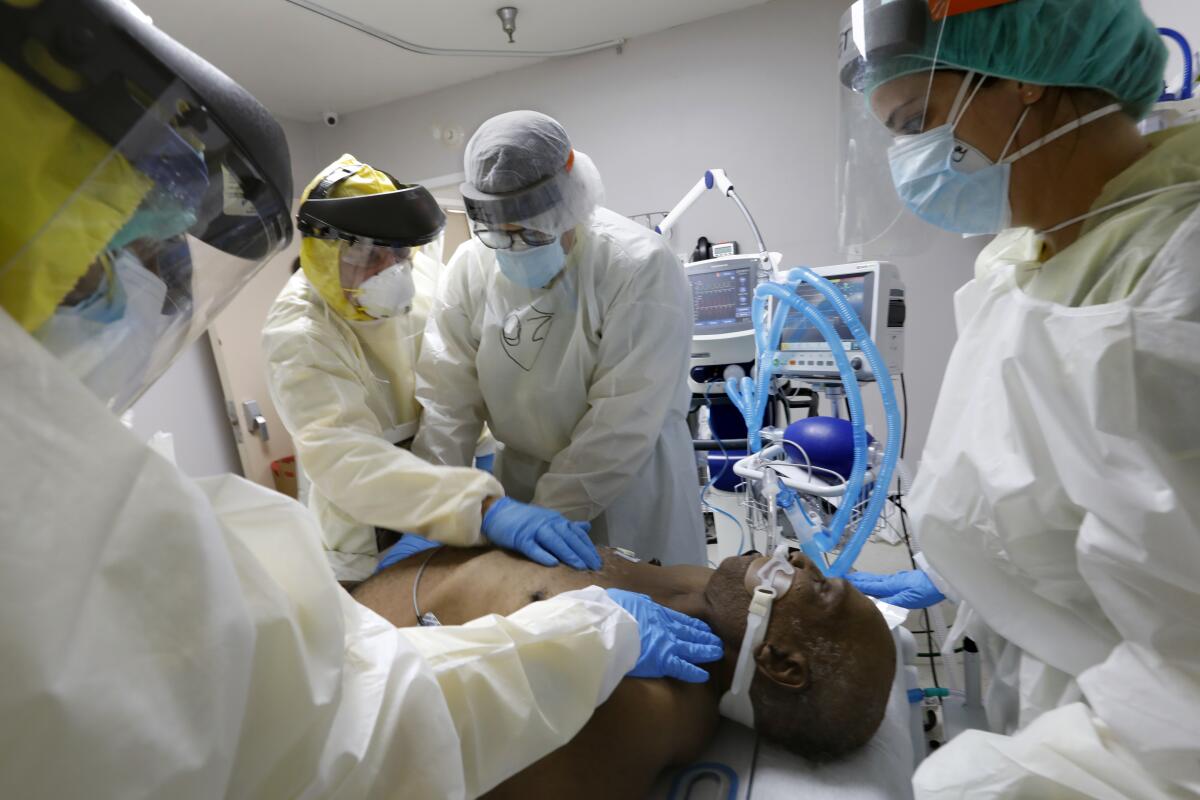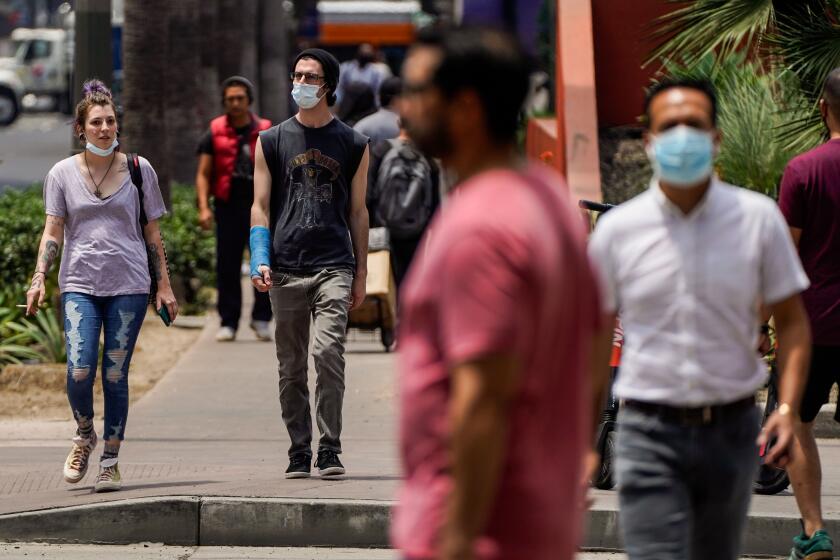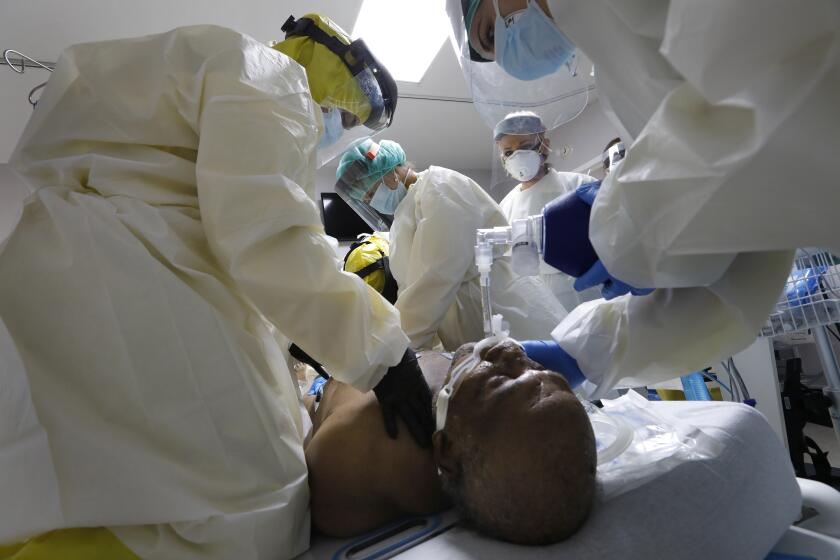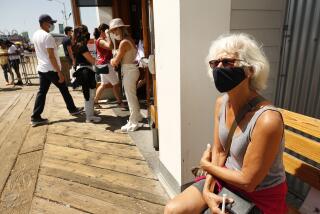COVID-19 death tolls now rising in key states after weeks of decline nationwide

- Share via
WASHINGTON — Soaring coronavirus infections in Texas, Arizona and Florida are pushing deaths from the disease back upward, reversing two months of declines and undercutting claims by the Trump administration that the pandemic is under control.
In Texas, where hospitals are being swamped by a wave of COVID-19 patients, the seven-day average of deaths hit 46 a day this week, more than double the daily average in mid-June, according to data compiled by Johns Hopkins University.
The average daily death toll in Arizona has also more than doubled in the last month. And in Florida, another state where infections are skyrocketing, the daily average of coronavirus-related deaths has jumped 60% in the last 2½ weeks.
“We should be very concerned,” said Dr. Eduardo Sanchez, a former Texas health commissioner who now serves as chief medical officer for prevention at the American Heart Assn. “And we should be thinking about what needs to be done to change this trend.”
California, where infections have also been soaring, hasn’t yet seen a sustained increase in deaths, but on Wednesday the state recorded 149 fatalities, according to a Times county-by-county tally, the highest number since mid-May.
‘Making sure we don’t have to go farther and close more businesses requires an individual commitment of each and every one of us,’ Mayor Garcetti says.
With other states across the South and West wrestling with surging infections, public health officials, hospital leaders and experts are eyeing the trends with growing anxiety, fearful they will soon see a reversal of what had been declining death tolls.
“The trend is very upsetting,” said Lisa McCormick, associate dean at the University of Alabama at Birmingham School of Public Health.
Alabama, where the number of new coronavirus cases has quadrupled since mid-May, has seen deaths hold relatively steady, but McCormick said few expect that pattern to hold.
Nationally, a new forecast from the Institute for Health Metrics and Evaluation at the University of Washington predicted that the U.S. would record more than 200,000 deaths related to the coronavirus by November, up from about 130,000 now.
“We can now see the projected trajectory of the epidemic into the fall, and many states are expected to experience significant increases in cases and deaths,” said Dr. Christopher Murray, director of the institute, whose disease models are closely followed worldwide.
Dr. Anthony Fauci, who heads the National Institute of Allergy and Infectious Diseases, suggested Wednesday that it may be time to reinstate restrictions on people’s activities. “I think any state that is having a serious problem, that state should seriously look at shutting down,” Fauci said in an interview with the Wall Street Journal.
The current uptick in deaths doesn’t approach the worst days of the pandemic this spring, when nearly 1,000 people were dying each day in New York.
And with deaths continuing to trend downward in some parts of the country, total daily fatalities in the U.S. remain significantly below their peak this year.
President Trump and others in his administration repeatedly have cited the overall downward trend in fatalities to argue that it is safe to reopen businesses and schools.
“We are encouraged that the average fatality rate continues to be low and steady,” Vice President Mike Pence told reporters Wednesday as administration officials urged schools across the country to allow students back in classrooms this fall.
Health officials across the country believe that coronavirus deaths remain much lower than their peak in part because those infected now tend to be younger and healthier than they were in the spring, making them better able to recover from an infection.
Doctors and hospitals have also developed better methods to treat COVID-19 patients, including using promising drugs such as remdesivir and dexamethasone, and being more selective about the use of ventilators for patients struggling to breathe.
“We are smarter because of the lessons we’ve learned nationally,” said Dr. David Lakey, chief medical officer at the University of Texas healthcare system.
But Lakey and others noted that the steep increase in patients being hospitalized with COVID-19 suggests that larger fatality numbers are likely in coming weeks.
This week, there are nearly 10,000 COVID-19 patients in Texas hospitals, according to state data, more than triple the total from three weeks ago.
This Houston hospital tried to prepare for the second wave of COVID-19, but was already 80% full this week as a nurse and doctor fell ill.
Deaths typically lag several weeks behind infections and hospitalizations, experts note. That means that the widespread socializing that occurred when the governors of Texas, Florida, Arizona and other states began loosening restrictions in the spring is only now starting to be reflected in death rates.
“The problem is that many people do not understand or recognize the time delay and do not attribute the hospitalization and deaths to a specific time and event where little social distancing and little masking is happening,” said Dr. Manoj Jain, an infectious-disease physician who is advising the mayor of Memphis, Tenn., on the coronavirus.
Tennessee’s daily deaths have been gradually trending up since May 22, when the governor issued an executive order allowing groups of up to 50 people to participate in social and recreational activities, the Johns Hopkins data show.
The widespread rise in infections and increasing death tallies distinguish the U.S. from most wealthy nations in Europe and East Asia that have much more successfully managed the pandemic.
Many of these countries were much more careful about reopening businesses after the virus first hit this spring.
But the U.S. experience is not unique, said Ali Mokdad, an epidemiologist at the Institute for Health Metrics and Evaluation who spent two decades at the U.S. Centers for Disease Control and Prevention.
Iran, which suffered one of the worst coronavirus outbreaks this spring, similarly locked down but then prematurely relaxed restrictions, Mokedad said, allowing infections and deaths to spring back. This week, the country recorded its highest number of COVID-19 fatalities since February.
“This is a pattern we have seen repeatedly,” Mokdad explained. “We were lulled into a false sense of security here. People let down their guard, and I’m very concerned the message is now coming out that we can be reassured and just reopen schools.
“We are heading in the wrong direction.”
More to Read
Get the L.A. Times Politics newsletter
Deeply reported insights into legislation, politics and policy from Sacramento, Washington and beyond. In your inbox three times per week.
You may occasionally receive promotional content from the Los Angeles Times.













